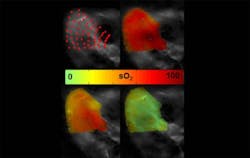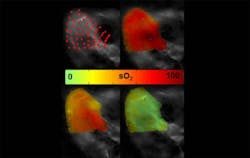Multispectral method is noninvasive for imaging tissue oxygenation
Researchers at the Technical University of Munich (TUM; Germany) have developed a multispectral approach to imaging tissue oxygenation noninvasively—that is, without the need for surgical intervention. The approach, known as multispectral optoacoustic tomography (MSOT), involves directing a weak pulsed laser beam at the tissue. Then, absorbing molecules and cells respond with a minuscule vibration that, in turn, creates sound signals. The sound signals are then picked up by sound sensors and translated into images. The way molecules and cells react to the laser beam offers insight into their optical and biochemical properties.
Related: Photoacoustic imaging progresses toward medical diagnostics
While MSOT can be used to tell how much oxygen can be found in blood, there is one major obstacle—the intensity of light changes with depth not only because light has been filtered through all the tissue layers that it passed through, but also because different tissue structures may have different properties that affect how light is scattered and absorbed. In the past, there have been several attempts to solve this problem by calculating how the tissue will affect the propagation of light. "However, due to the high optical complexity of tissues, this approach so far could not be flexibly applied in optoacoustic images of tissues of living subjects," says Stratis Tzoumas, first author of the paper describing the work.
Prof. Vasilis Ntziachristos, chair for biological imaging at TUM and director of the Institute for Biological and Medical Imaging at the Helmholtz Centre (Munich, Germany), led the work. Ntziachristos, along with Tzoumas and their colleagues, built on the MSOT approach with a method they call eigenspectra MSOT (eMSOT), which avoids simulating the path of light through complex tissue altogether. Instead, the new method is based on the discovery that the spectrum of light propagating in tissue can be described by using a small number of basic spectra. eMSOT uses data from a conventional MSOT device combined with a new algorithm that is based on this novel way of describing the light spectrum to correct for the effects of light propagation in tissue and obtain accurate images of blood oxygenation in tissue.
With eMSOT, the research team was able to visualize the blood oxygenation level of living tissue up to 1 cm below the skin surface. "Theoretically, the imaging depth can be extended to more than that," Tzoumas says. "There is, however, a limit at about three because at some point, light cannot penetrate the tissue any further."
The scientists observed a vastly improved accuracy in eMSOT over previous optical and optoacoustic approaches. Apart from being noninvasive and radiation-free, eMSOT also delivers comparable or higher resolution both spatially and temporally than other optical imaging methods. "Information about the amount of oxygen in tissue is important when it comes to various fields in research and treatment—for example, tumor growth or in measurements of metabolism," Ntziachristos says.
Full details of the work appear in the journal Nature Communications; for more information, please visit http://dx.doi.org/10.1038/ncomms12121.

